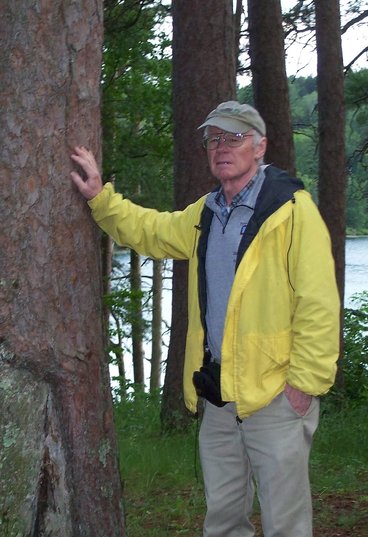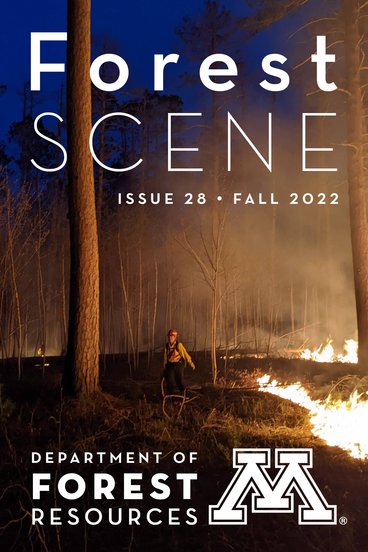
Dr. William Patterson can tell you, without a moment’s hesitation, the distance and direction from his home in Western Massachusetts to the Martha’s Vineyard grass airstrip that benefitted from a prescribed burn early in his career, or the blueberry field near Orono, where – as a freshman forestry student - he was first introduced to controlled burning. He can tell you about the quantity and categories of tree cover in Massachusetts versus Maine, and the logging that converted pine forests to aspen at Itasca State Park, Minnesota.
After earning his bachelor’s degree from Maine, Bill began his graduate studies in the Department of Forest Resources, University of Minnesota when researchers, industry stakeholders and the general public were first considering fire as a forest management tool. When Bill arrived, his faculty advisor Dr. Henry Hansen was contemplating initial burns at Itasca.
Bill learned that fire played an important role in Midwestern forests. “Historically, Indigenous Peoples were burning, and we now know that they burned to manage vegetation for specific resource benefits.”
Before completing his Ph.D. in 1978, Bill worked for the Minnesota State Planning Agency as a terrestrial ecosystem analyst evaluating the impacts of a proposed copper-nickel mining operation near Ely. When a faculty position in urban forest ecology opened at the University of Massachusetts/Amherst, he welcomed the opportunity to move back to New England. It took him about a year to decide that he would teach fire ecology instead of urban forestry.
Bill offered his first fire management course in 1981, and in 1989 added a fire control class which drew students from UMass as well as Mount Holyoke, Smith, Amherst, and Hampshire Colleges. The coursework allowed students to earn a Red Card - an interagency certification required for summer jobs fighting wildland fires.
In New England, igniting controlled burns was a new idea, despite the fact that Indigenous Peoples burned the Northeastern landscape long before the Pilgrims arrived. Bill worked with agencies including the National Park Service, The Nature Conservancy, and the Army National Guard to burn as many as several hundred acres at a time to reduce fire hazard and promote threatened and endangered species habitat in pine-oak woodlands and barrens along the North Atlantic Coast.
The 1988 Yellowstone wildfires represented a turning point, in Bill’s opinion, in public perception of the need for active fire management in fire-adapted landscapes, even in New England.

While training students, Bill emphasized that keys to getting a job in natural resources management includes volunteering, getting summer jobs, being an intern -- whatever it takes to get field experience. “I tell my students, “It’s not who or what you know, it’s who knows you. Get out and interact with professionals who are doing it on the landscape.” Network with professionals in the field; show them you are physically fit, know the basics and are eager to learn more, and that you are willing to work hard and not necessarily by the clock. “You can’t just decide halfway through mopping up a burn that it is time for you to go home.”
Bill’s passion for experiential learning persists: “Now that I am older, I can’t stay out all night on a burn; but I can pass on some of what I learned the hard way – through trial and (sometimes) error. You can never know everything, but the more you learn in the field, the better.” To that end, Bill created The William A Patterson III Fund for Fire Ecology in the Department of Forest Resources to support students interested in a career in fire ecology and management. The fund provides grants for off-campus experiential learning and professional development. “So many faculty, staff and fellow students helped me along the way – both at Maine and Minnesota. It is now time for me to give back.”
Bill retired in 2010 and still teaches the fire control course on a volunteer basis. He also assists undergraduate and graduate students and junior faculty with field-based forest and fire management activities. He is a Community Representative with the North Atlantic Fires Science Exchange. When asked if he has any time for hobbies Bill responded “Fire is my hobby. It was my calling. Now my calling is to enthusiastically pass on some of what I’ve learned.”

The Forest Scene newsletter is published biannually in the spring and fall, featuring stories and updates from the Department of Forest Resources. Readers can download issue 28 of Forest Scene as an interactive PDF that is fully tagged and compatible with most screen readers, or read the individual stories here in a web-based format.
